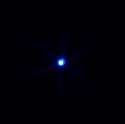RX J1856.5−3754
RX J1856.5−3754 (also called RX J185635−3754, RX J185635−375, and various other designations) is a nearby neutron star in the constellation Corona Australis. It is the closest neutron star to Earth yet discovered.
 X-ray image of RX J1856.5−3754 | |
| Observation data Epoch 1996.7 Equinox J2000.0[1] | |
|---|---|
| Constellation | Corona Australis |
| Right ascension | 18h 56m 35s [1] |
| Declination | −37° 54′ 36″[1] |
| Apparent magnitude (V) | ~25.6[1] |
| Details | |
| Mass | 0.9 M☉ |
| Radius | 19–41 km |
| Age | 1 million years |
| Other designations | |
RX J185635−3754, 1ES 1853−37.9, 1RXS J185635.1−375433 | |
| Database references | |
| SIMBAD | data |
Discovery and location
RX J1856.5−3754 is thought to have formed in a supernova explosion of its companion star about one million years ago and is moving at 108 km/s across the sky. It was discovered in 1992, and observations in 1996 confirmed that it is a neutron star, the closest to Earth discovered to date.[2]
It was originally thought to be about 150–200 light-years away,[3] but further observations using the Chandra X-ray Observatory in 2002 indicate that its distance is greater—about 400 light-years.[4][5]
RX J1856 is one of the Magnificent Seven, a group of young neutron stars at distances between 130 and 500 parsecs (400 and 1600 light-years) of Earth.
Quark star hypothesis
By combining Chandra X-ray Observatory and Hubble Space Telescope data, astronomers previously estimated that RX J1856 radiates like a solid body with a temperature of 700,000 °C and has a diameter of about 4–8 km. This estimated size was too small to reconcile with the standard models of neutron stars, and it was therefore suggested that it might be a quark star.[4]
However, later refined analysis[5][6] of improved Chandra and Hubble observations revealed that the surface temperature of the star is lower, only 434,000 °C, and respectively the diameter is larger, about 14 km (with account of the effects of general relativity, the observed radius appears about 17 km).[5] Thus, RX J1856.5-3754 is now excluded from the list of quark star candidates.[6]
See also
- 3C 58, a possible quark star.
References
- RX-J185635-375 at jumk.de
- RX J1856.5-3754 and 3C58: Cosmic X-rays May Reveal New Form of Matter Chandra X-ray Observatory. July 16, 2009.
- Walter, Frederick M.; Lattimer, James M., The Astrophysical Journal, 2002
- RX J185635-3754 - an Isolated Neutron Star, F. M. Walter, web page at the Department of Physics and Astronomy, State University of New York at Stony Brook. Accessed on line June 29, 2007.
- Rees, Martin (2012). Universe. Dorling Kindersley. p. 528. ISBN 978-1-4093-7650-7.
- "The Mystery of the Lonely Neutron Star". European Southern Observatory press release, September 11, 2000. Accessed online at spaceref.com May 20, 2007.
- Drake J. J.; et al. (2002). "Is RX J1856.5-3754 a Quark Star?". Astrophys. J. 572 (2): 996–1001. arXiv:astro-ph/0204159. Bibcode:2002ApJ...572..996D. doi:10.1086/340368.
- Ho W. C. G.; et al. (2007). "Magnetic hydrogen atmosphere models and the neutron star RX J1856.5–3754". Monthly Notices of the Royal Astronomical Society. 375 (2): 821–830. arXiv:astro-ph/0612145v1. Bibcode:2007MNRAS.375..821H. doi:10.1111/j.1365-2966.2006.11376.x.
- Truemper, J. E.; Burwitz, V.; Haberl, F.; Zavlin, V. E. (June 2004). "The puzzles of RX J1856.5-3754: neutron star or quark star?". Nuclear Physics B: Proceedings Supplements. 132: 560–565. arXiv:astro-ph/0312600. Bibcode:2004NuPhS.132..560T. doi:10.1016/j.nuclphysbps.2004.04.094.
External links
| Wikimedia Commons has media related to RX J1856.5−3754. |
- Is RX J185635-375 a Quark Star?
- NASA Astronomy Picture of the Day: RX J185635-375: Candidate Quark Star (14 April 2002)
- Bare Quark Stars or Naked Neutron Stars? The Case of RX J1856.5-3754
- RX J185635-3754 - an Isolated Neutron Star
- News Release STScI-1997-32: Hubble Sees a Neutron Star Alone in Space